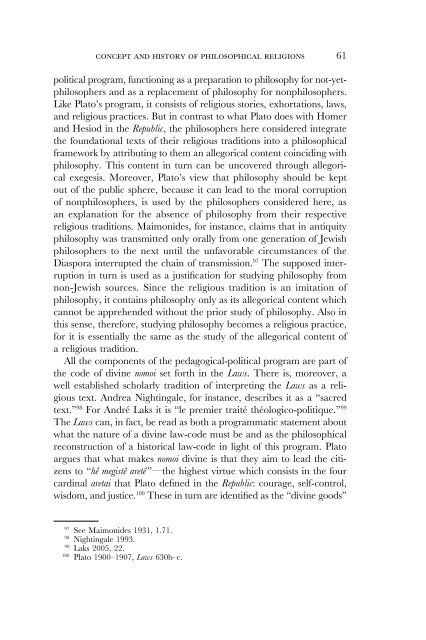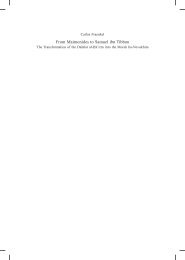Download PDF - Carlos F. Fraenkel
Download PDF - Carlos F. Fraenkel
Download PDF - Carlos F. Fraenkel
Create successful ePaper yourself
Turn your PDF publications into a flip-book with our unique Google optimized e-Paper software.
concept and history of philosophical religions 61political program, functioning as a preparation to philosophy for not-yetphilosophersand as a replacement of philosophy for nonphilosophers.Like Plato’s program, it consists of religious stories, exhortations, laws,and religious practices. But in contrast to what Plato does with Homerand Hesiod in the Republic, the philosophers here considered integratethe foundational texts of their religious traditions into a philosophicalframework by attributing to them an allegorical content coinciding withphilosophy. This content in turn can be uncovered through allegoricalexegesis. Moreover, Plato’s view that philosophy should be keptout of the public sphere, because it can lead to the moral corruptionof nonphilosophers, is used by the philosophers considered here, asan explanation for the absence of philosophy from their respectivereligious traditions. Maimonides, for instance, claims that in antiquityphilosophy was transmitted only orally from one generation of Jewishphilosophers to the next until the unfavorable circumstances of theDiaspora interrupted the chain of transmission. 97 The supposed interruptionin turn is used as a justification for studying philosophy fromnon-Jewish sources. Since the religious tradition is an imitation ofphilosophy, it contains philosophy only as its allegorical content whichcannot be apprehended without the prior study of philosophy. Also inthis sense, therefore, studying philosophy becomes a religious practice,for it is essentially the same as the study of the allegorical content ofa religious tradition.All the components of the pedagogical-political program are part ofthe code of divine nomoi set forth in the Laws. There is, moreover, awell established scholarly tradition of interpreting the Laws as a religioustext. Andrea Nightingale, for instance, describes it as a “sacredtext.” 98 For André Laks it is “le premier traité théologico-politique.” 99The Laws can, in fact, be read as both a programmatic statement aboutwhat the nature of a divine law-code must be and as the philosophicalreconstruction of a historical law-code in light of this program. Platoargues that what makes nomoi divine is that they aim to lead the citizensto “hê megistê aretê ”—the highest virtue which consists in the fourcardinal aretai that Plato defined in the Republic: courage, self-control,wisdom, and justice. 100 These in turn are identified as the “divine goods”97See Maimonides 1931, 1.71.98Nightingale 1993.99Laks 2005, 22.100Plato 1900–1907, Laws 630b–c.



